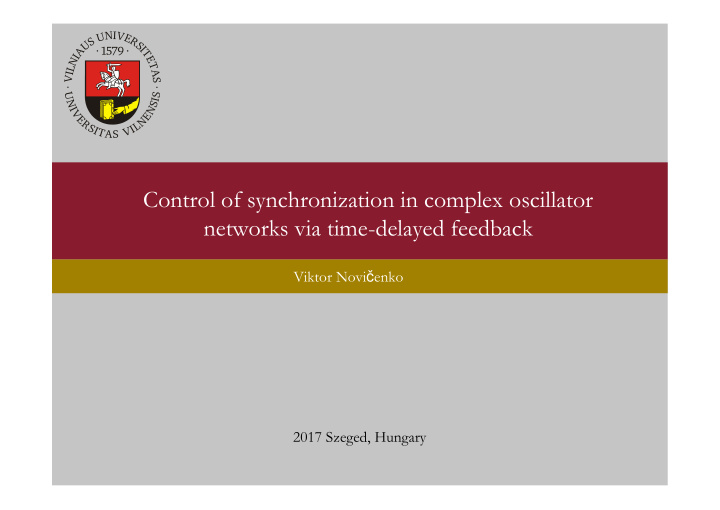



Control of synchronization in complex oscillator networks via time-delayed feedback Viktor Novi č enko 2017 Szeged, Hungary
Motivation The synchronous behavior can be desirable or harmful. • Power grids • Parkinson’s disease, essential tremor • Pedestrians on a bridge • Cardiac pacemaker cells • Internal circadian clock The ability to control synchrony in oscillatory networks covers a wide range of real-world applications.
Phase reduction method Phase reduction method allows the approximation of high dimensional dynamics of oscillators with a single-phase variable. x has periodic solution ξ ξ f ( x ) t T t ϑ phase gradually increase from 0 to T 1 ϑ ε Here is a phase response curve – the periodic z x f ( x ) g ( x , t ) z T solution of the adjoint equation z D f ( ξ ) ) ϑ ε ϑ ϑ ξ T ξ Initial condition for the phase response curve: T 1 z g ( , t z ( 0 ) ( 0 ) 1 τ τ τ ε T T T x t , x t x f g x t , t z t z t A t z t B t τ where the matrices A t D f ξ ( t ), ξ ( t ) 1 τ ϑ ε ϑ ϑ T 1 z g ξ , t B t D f ξ ( t ), ξ ( t ) 2 0 τ τ T T Initial condition for the phase response curve: z 0 ξ ( 0 ) z s B s ξ ( s ) ds 1 τ V. Novičenko, K. Pyragas, Physica D 241 , 1090–1098 (2012) K. Kotani et al, Phys. Rev. Lett. 109 , 044101 (2012)
Complex oscillator network – the phase reduction approach Weakly coupled near-identical limit cycle oscillators: without control under the delayed feedback control ε ε τ ε ε x f ( x ) f ( x ) a g ( x , x ) K x t x t x f ( x ) f ( x ) a g ( x , x ) i i i i ij i j i i i i ij i j i i i j j ϑ t τ τ x t x t x t T x t x t T T i i i i i i i i i i i π 2 ϕ ϑ where t t t By treating a free oscillator as i i i i T i ε x f ( x ) f ( x ) K x t T x t i i i i i i i ψ average ϕ t t over the period T i i Applying the phase reduction method for systems with time-delay ψ ω ε ψ ψ a h i i ij j i j ψ ω ε ψ ψ ω eff eff here the frequencies a h i i ij j i i i j τ ε T i ω ω α ε α eff eff i K 1 K Synchronization condition: i i T ψ ψ ψ 1 2 N V. Novičenko, Phys. Rev. E 92 , 022919 (2015)
Control of synchronization in a complex oscillator network K 0 0 ε ε τ x f ( x ) f ( x ) g ( x , x ) K x x a t t 0 0 0 i i i i ij i j i i i Let’s say K j 0 ψ ω ε ψ ψ eff eff a h 0 0 0 0 i i ij j i j T τ 1 T i ε ξ α 1 where 1 1 ω ω α ε α C z s s ds eff K eff i 1 K K i i KC T 0 τ τ (i) The delay times are the same T i ω eff α K ω synchronization cannot be controlled i i (ii) The delay times are equal to the natural periods τ ω ω eff T i i i i (iii) The delay times are τ ω eff T ω i i i 0 α i T 1 K ψ ψ ψ is a stable solution, under additional assumptions: h 0 0 , h 0 0 t t t 1 2 N V. Novičenko, Phys. Rev. E 92 , 022919 (2015)
Numerical demonstrations 8 FitzHugh-Nagumo oscillators: ε 10 ε eff 4 eff 4 ε ε 5 3 6 10 1 . 6 10 5 10 F t K x t T x t 1 1 1 1 V. Novičenko, Phys. Rev. E 92 , 022919 (2015)
Odd number limitation 1 x f ( x ) K x t T x t α 1 i i i i i i K KC According to the odd number limitation theorem, the periodic solution is unstable, if ξ ξ t T t i i i KC 1 E. W. Hooton and A. Amann, Phys. Rev. Lett. 109 , 154101 (2012) What happen for ? K 1 / C Motion of the Floquet multipliers
Summary The delayed feedback control force applied to a limit cycle oscillator changes its stability properties and, as a consequence, perturbation-induced phase response. The phase model of the oscillator network shows that the coupling strength and the frequencies depend on the parameters of the control. Advantages: • does not require any information about the oscillator model • does not depends on network topology • can be simple realized in experiment • theoretically synchronization can be controlled for the arbitrary small/large coupling strength • the control scheme has only two parameters: control gain and delay time Disadvantages: • the phase model can be derived only for a weak coupling • the control force can disrupt the stability of periodic orbit
The end
Recommend
More recommend